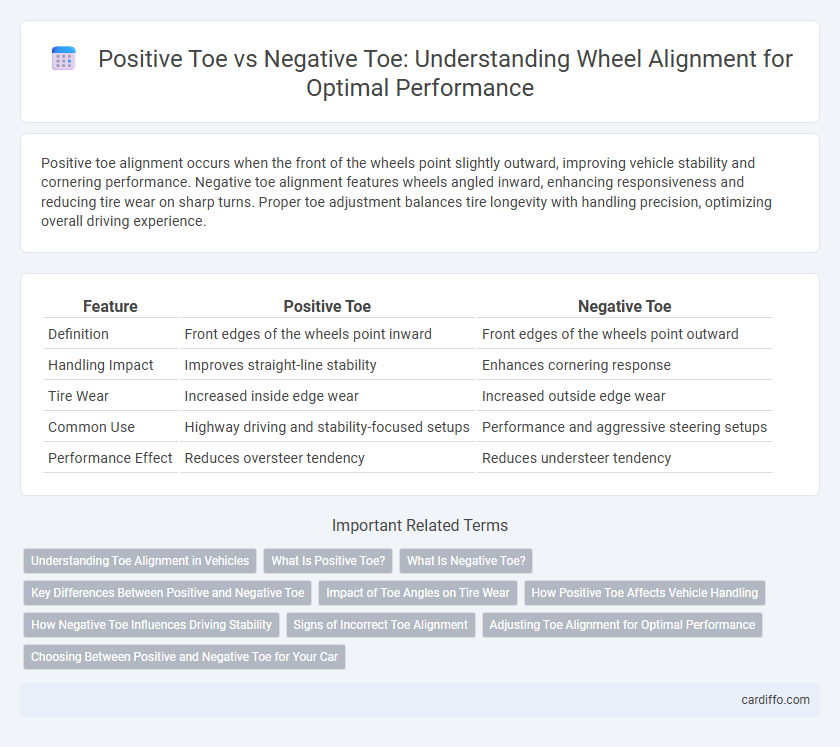Positive toe alignment occurs when the front of the wheels point slightly outward, improving vehicle stability and cornering performance. Negative toe alignment features wheels angled inward, enhancing responsiveness and reducing tire wear on sharp turns. Proper toe adjustment balances tire longevity with handling precision, optimizing overall driving experience.
Table of Comparison
| Feature | Positive Toe | Negative Toe |
|---|---|---|
| Definition | Front edges of the wheels point inward | Front edges of the wheels point outward |
| Handling Impact | Improves straight-line stability | Enhances cornering response |
| Tire Wear | Increased inside edge wear | Increased outside edge wear |
| Common Use | Highway driving and stability-focused setups | Performance and aggressive steering setups |
| Performance Effect | Reduces oversteer tendency | Reduces understeer tendency |
Understanding Toe Alignment in Vehicles
Toe alignment refers to the angle at which a vehicle's tires point relative to its centerline, crucial for ensuring optimal handling and tire wear. Positive toe, or toe-in, occurs when the front edges of the tires are closer together than the rear edges, enhancing straight-line stability and reducing oversteer. Negative toe, or toe-out, means the front edges are farther apart, improving cornering responsiveness but potentially increasing tire wear during straight driving.
What Is Positive Toe?
Positive toe refers to the wheel alignment condition where the front of the wheels point inward toward the vehicle's centerline. This alignment setting improves straight-line stability and enhances vehicle handling during cornering by promoting better tire contact with the road surface. Proper positive toe adjustment helps reduce tire wear and ensures balanced steering response.
What Is Negative Toe?
Negative toe, also known as toe-out alignment, occurs when the front edges of the tires point away from the vehicle's centerline, causing the wheels to angle outward. This alignment setting can lead to uneven tire wear, reduced handling stability, and increased rolling resistance, affecting overall vehicle performance. Negative toe is often used in performance or off-road vehicles to enhance cornering capabilities but requires precise adjustment to avoid adverse effects.
Key Differences Between Positive and Negative Toe
Positive toe means the front of the wheels point outward from the vehicle's centerline, causing increased tire wear on the outer edges and potentially improving cornering stability. Negative toe occurs when the front of the wheels point inward toward the centerline, enhancing straight-line stability but possibly reducing tire life due to inner edge wear. The key difference lies in their impact on handling characteristics and tire wear patterns, influencing vehicle performance and alignment settings.
Impact of Toe Angles on Tire Wear
Positive toe causes the tires to point outward, leading to increased wear on the outer edges of the tread, while negative toe causes the tires to point inward, resulting in accelerated wear on the inner edges. Incorrect toe angles create uneven tire wear patterns, reducing tire lifespan and compromising vehicle handling. Properly adjusted toe settings optimize tire contact with the road, improving wear distribution and enhancing overall alignment performance.
How Positive Toe Affects Vehicle Handling
Positive toe, where the front edges of the tires point inward, enhances straight-line stability by promoting better directional control during acceleration and high-speed driving. This alignment reduces the tendency for the vehicle to wander, improving overall traction and cornering predictability. However, excessive positive toe can increase tire wear and decrease fuel efficiency due to added rolling resistance.
How Negative Toe Influences Driving Stability
Negative toe, where the front of the wheels points inward, enhances driving stability by improving straight-line tracking and reducing tramlining on uneven surfaces. This alignment characteristic increases tire contact patch during cornering, resulting in better grip and precise steering response. However, excessive negative toe can lead to increased tire wear and reduced fuel efficiency, necessitating a balanced adjustment for optimal performance.
Signs of Incorrect Toe Alignment
Signs of incorrect toe alignment include uneven tire wear, such as feathering or excessive inner or outer edge wear, which indicates either positive or negative toe settings. Poor vehicle handling, like pulling to one side or unstable steering response, also signals misaligned toe angles. Drivers may notice a wandering sensation or vibrations at higher speeds, reflecting imbalanced toe adjustments causing suboptimal wheel contact with the road.
Adjusting Toe Alignment for Optimal Performance
Adjusting toe alignment involves setting the wheels to positive toe (toe-out) or negative toe (toe-in) angles to enhance vehicle stability and tire wear. Positive toe typically improves cornering response by allowing the front wheels to turn slightly outward, while negative toe enhances straight-line stability by angling wheels inward. Precise toe alignment optimizes traction, reduces tire scrubbing, and maximizes overall handling performance.
Choosing Between Positive and Negative Toe for Your Car
Choosing between positive toe and negative toe alignment depends on your driving style and vehicle handling preferences. Positive toe, where the front edges of the tires point inward, enhances straight-line stability and tire wear, making it ideal for daily commuting and highway driving. Negative toe, with the front edges of the tires angled outward, improves cornering response and agility, benefiting performance-oriented or sport driving.
Positive Toe vs Negative Toe Infographic

 cardiffo.com
cardiffo.com